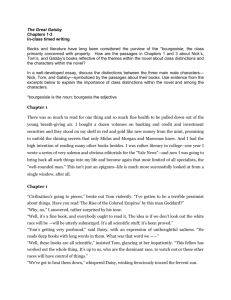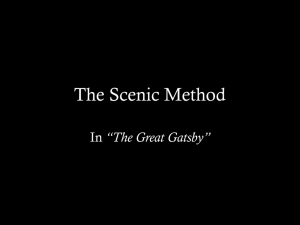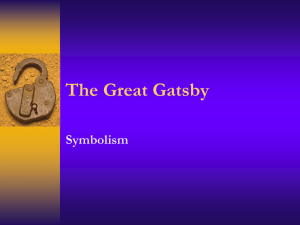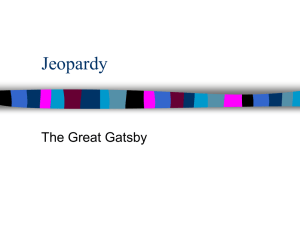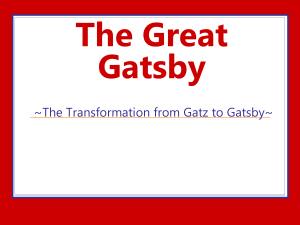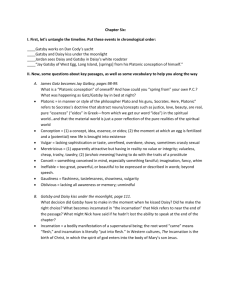Higher Revision Pack
advertisement
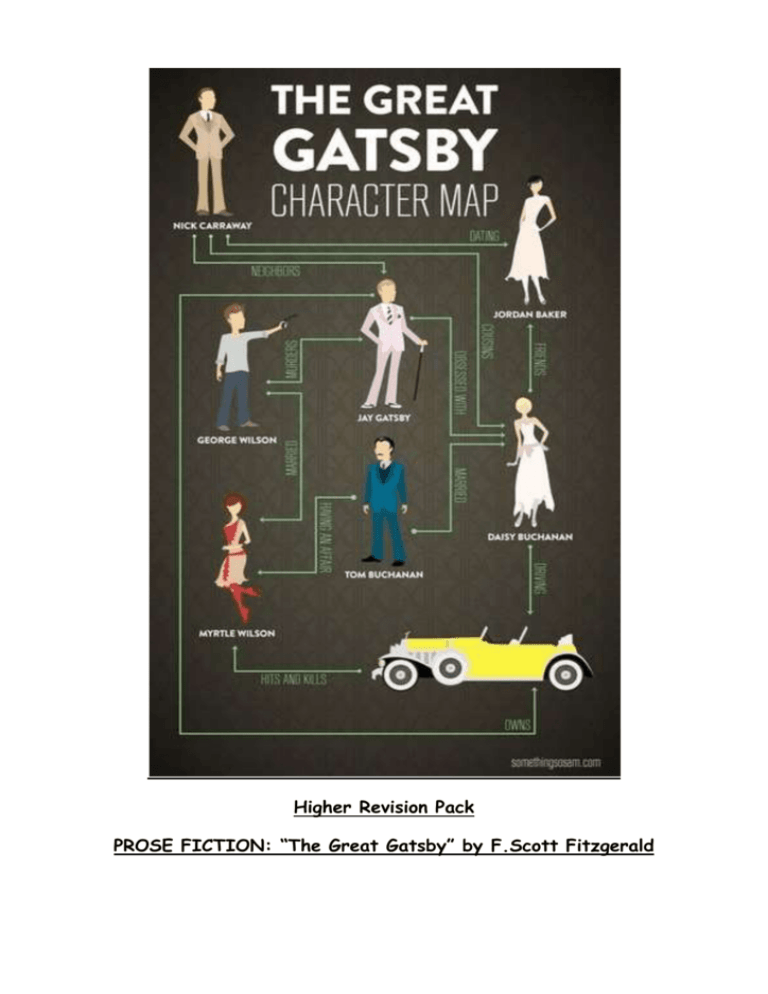
Higher Revision Pack PROSE FICTION: “The Great Gatsby” by F.Scott Fitzgerald PROSE: The Great Gatsby, By F. Scott Fitzgerald This is a guide to help you with revision of the novel for the critical essay section of the exam. When looking at the paper there will be several different types of essay; you should write two essays from DIFFERENT genres. For example one PROSE essay (a novel/short story) and one DRAMA essay (a play). Context of the Novel Fitzgerald is the most famous writer of 1920s America, an era that he dubbed “the Jazz Age.” Written in 1925 the American economy soared, bringing a lot of wealth prosperity to the nation. Prohibition, the ban on the sale and consumption of alcohol mandated by the Eighteenth Amendment to the Constitution (1919), made millionaires out of bootleggers, and an underground culture of revelry sprang up. Sprawling private parties managed to elude police notice, and “speakeasies”—secret clubs that sold liquor—thrived. The chaos and violence of World War I left America in a state of shock, and the generation that fought the war turned to wild and extravagant living to make up for it. Where before people tended to be reserved in their behaviour, things changed and money, opulence (wealth or abundance), and exuberance (overly excited, joyful) became the order of the day. Like Nick in The Great Gatsby, Fitzgerald found this new lifestyle seductive and exciting, and, like Gatsby, he had always idolized the very rich. Now he found himself in an era in which unrestrained materialism set the tone of society, particularly in the large cities of the East. Even so, like Nick, Fitzgerald saw through the glitter of the Jazz Age to the moral emptiness and hypocrisy beneath, and part of him longed for this absent moral centre. In many ways, The Great Gatsby represents Fitzgerald’s attempt to confront his conflicting feelings about the Jazz Age. Like Gatsby, Fitzgerald was driven by his love for a woman who symbolized everything he wanted, even as she led him toward everything he despised. Plot Summary Nick Carraway, a young man from Minnesota, moves to New York in the summer of 1922 to learn about the bond business. He rents a house in the West Egg district of Long Island, a wealthy but unfashionable area populated by the new rich, a group who have made their fortunes too recently to have established social connections and who are prone to garish displays of wealth. Nick’s nextdoor neighbour in West Egg is a mysterious man named Jay Gatsby, who lives in a gigantic Gothic mansion and throws extravagant parties every Saturday night. 2 Nick is unlike the other inhabitants of West Egg—he was educated at Yale and has social connections in East Egg, a fashionable area of Long Island home to the established upper class. Nick drives out to East Egg one evening for dinner with his cousin, Daisy Buchanan, and her husband, Tom, an old classmate of Nick’s at Yale. Daisy and Tom introduce Nick to Jordan Baker, a beautiful, cynical young woman with whom Nick begins a romantic relationship. Nick also learns a bit about Daisy and Tom’s marriage: Jordan tells him that Tom has a lover, Myrtle Wilson, who lives in the valley of ashes, a gray industrial dumping ground between West Egg and New York City. Not long after this revelation, Nick travels to New York City with Tom and Myrtle. At a vulgar(lacking good taste), gaudy (vulgarly bright and distasteful) party in the apartment that Tom keeps for the affair, Myrtle begins to taunt Tom about Daisy, and Tom responds by breaking her nose. As the summer progresses, Nick eventually garners an invitation to one of Gatsby’s legendary parties. He encounters Jordan Baker at the party, and they meet Gatsby himself, a surprisingly young man who affects an English accent, has a remarkable smile, and calls everyone “old sport.” Gatsby asks to speak to Jordan alone, and, through Jordan, Nick later learns more about his mysterious neighbour. Gatsby tells Jordan that he knew Daisy in Louisville in 1917 and is deeply in love with her. He spends many nights staring at the green light at the end of her dock, across the bay from his mansion. Gatsby’s extravagant lifestyle and wild parties are simply an attempt to impress Daisy. Gatsby now wants Nick to arrange a reunion between himself and Daisy, but he is afraid that Daisy will refuse to see him if she knows that he still loves her. Nick invites Daisy to have tea at his house, without telling her that Gatsby will also be there. After an initially awkward reunion, Gatsby and Daisy re-establish their connection. Their love rekindled, they begin an affair. After a short time, Tom grows increasingly suspicious of his wife’s relationship with Gatsby. At a luncheon at the Buchanans’ house, Gatsby stares at Daisy with such undisguised passion that Tom realizes Gatsby is in love with her. Though Tom is himself involved in an extramarital affair, he is deeply outraged by the thought that his wife could be unfaithful to him. He forces the group to drive into New York City, where he confronts Gatsby in a suite at the Plaza Hotel. Tom asserts that he and Daisy have a history that Gatsby could never understand, and he announces to his wife that Gatsby is a criminal—his fortune comes from bootlegging alcohol and other illegal activities. Daisy realizes that her allegiance is to Tom, and Tom contemptuously sends her back to East Egg with Gatsby, attempting to prove that Gatsby cannot hurt him. When Nick, Jordan, and Tom drive through the valley of ashes, however, they discover that Gatsby’s car has struck and killed Myrtle, Tom’s lover. They rush back to Long Island, where Nick learns from Gatsby that Daisy was driving the car when it struck Myrtle, but that Gatsby intends to take the blame. The next day, Tom tells Myrtle’s husband, George, that Gatsby was the driver of the car. 3 George, who has leapt to the conclusion that the driver of the car that killed Myrtle must have been her lover, finds Gatsby in the pool at his mansion and shoots him dead. He then fatally shoots himself. Nick stages a small funeral for Gatsby, ends his relationship with Jordan, and moves back to the Midwest to escape the disgust he feels for the people surrounding Gatsby’s life and for the emptiness and moral decay of life among the wealthy on the East Coast. Nick reflects that just as Gatsby’s dream of Daisy was corrupted by money and dishonesty, the American dream of happiness and individualism has disintegrated into the mere pursuit of wealth. Though Gatsby’s power to transform his dreams into reality is what makes him “great,” Nick reflects that the era of dreaming—both Gatsby’s dream and the American dream—is over. Major Character Summaries Nick Carraway - The novel’s narrator, Nick is a young man from Minnesota who, after being educated at Yale and fighting in World War I, goes to New York City to learn the bond business. Honest, tolerant, and inclined to reserve judgment, Nick often serves as a confidant for those with troubling secrets. After moving to West Egg, a fictional area of Long Island that is home to the newly rich, Nick quickly befriends his next-door neighbour, the mysterious Jay Gatsby. As Daisy Buchanan’s cousin, he facilitates the rekindling of the romance between her and Gatsby. The Great Gatsby is told entirely through Nick’s eyes; his thoughts and perceptions shape and colour the story. Jay Gatsby - The protagonist (main character) of the novel, Gatsby is a fabulously wealthy young man living in a Gothic mansion in West Egg. He is famous for the lavish parties he throws every Saturday night, but no one knows where he comes from, what he does, or how he made his fortune. As the novel progresses, Nick learns that Gatsby was born James Gatz on a farm in North Dakota; working for a millionaire made him dedicate his life to the achievement of wealth. When he met Daisy while training to be an officer in Louisville, he fell in love with her. Nick also learns that Gatsby made his fortune through criminal activity, as he was willing to do anything to gain the social position he thought necessary to win Daisy. Nick views Gatsby as a deeply flawed man, dishonest and vulgar, whose extraordinary optimism and power to transform his dreams into reality make him “great” nonetheless. Daisy Buchanan - Nick’s cousin, and the woman Gatsby loves. As a young woman in Louisville before the war, Daisy was courted by a number of officers, including Gatsby. She fell in love with Gatsby and promised to wait for him. However, Daisy harbours a deep need to be loved, and when a wealthy, powerful young man named Tom Buchanan asked her to marry him, Daisy decided not to wait for Gatsby after all. Now a beautiful socialite, Daisy lives with Tom across from Gatsby in the fashionable East Egg district of Long Island. She is sardonic 4 and somewhat cynical, and behaves superficially to mask her pain at her husband’s constant infidelity. Tom Buchanan - Daisy’s immensely wealthy husband, once a member of Nick’s social club at Yale. Powerfully built and hailing from a socially solid old family, Tom is an arrogant, hypocritical bully. His social attitudes are laced with racism and sexism, and he never even considers trying to live up to the moral standard he demands from those around him. He has no moral qualms (doesn’t feel bad) about his own affair with Myrtle, but when he begins to suspect Daisy and Gatsby of having an affair, he becomes outraged and forces a confrontation. Jordan Baker - Daisy’s friend, a woman with whom Nick becomes romantically involved during the course of the novel. A competitive golfer, Jordan represents one of the “new women” of the 1920s—cynical, boyish, and self-centered. Jordan is beautiful, but also dishonest: she cheated in order to win her first golf tournament and continually bends the truth. Myrtle Wilson - Tom’s lover, whose lifeless husband George owns a run-down garage in the valley of ashes. Myrtle herself possesses a fierce vitality and desperately looks for a way to improve her situation. Unfortunately for her, she chooses Tom, who treats her as a mere object of his desire. George Wilson - Myrtle’s husband, the lifeless, exhausted owner of a run-down auto shop at the edge of the valley of ashes. George loves and idealizes Myrtle, and is devastated by her affair with Tom. George is consumed with grief when Myrtle is killed. George is comparable to Gatsby in that both are dreamers and both are ruined by their unrequited love for women who love Tom. Owl Eyes - The eccentric, bespectacled drunk whom Nick meets at the first party he attends at Gatsby’s mansion. Nick finds Owl Eyes looking through Gatsby’s library, astonished that the books are real. Klipspringer - The shallow freeloader who seems almost to live at Gatsby’s mansion, taking advantage of his host’s money. As soon as Gatsby dies, Klipspringer disappears—he does not attend the funeral, but he does call Nick about a pair of tennis shoes that he left at Gatsby’s mansion. Meyer Wolfsheim - Gatsby’s friend, a prominent figure in organized crime. Before the events of the novel take place, Wolfsheim helped Gatsby to make his fortune bootlegging illegal liquor. His continued acquaintance with Gatsby suggests that Gatsby is still involved in illegal business. Analysis of Major Characters Jay Gatsby The title character of The Great Gatsby is a young man, around thirty years old, who rose from an impoverished childhood in rural North Dakota to become 5 fabulously wealthy. However, he achieved this by participating in organized crime, including distributing illegal alcohol and trading in stolen securities. From his early youth, Gatsby despised poverty and longed for wealth and sophistication—he dropped out of St. Olaf’s College after only two weeks because he could not bear the janitorial job with which he was paying his tuition. Though Gatsby has always wanted to be rich, his main motivation in acquiring his fortune was his love for Daisy Buchanan, whom he met as a young military officer in Louisville before leaving to fight in World War I in 1917. Gatsby immediately fell in love with Daisy’s aura of luxury, grace, and charm, and lied to her about his own background in order to convince her that he was good enough for her. Daisy promised to wait for him when he left for the war, but married Tom Buchanan in 1919, while Gatsby was studying at Oxford after the war in an attempt to gain an education. From that moment on, Gatsby dedicated himself to winning Daisy back, and his acquisition of millions of dollars, his purchase of a gaudy mansion on West Egg, and his lavish weekly parties are all merely means to that end. Fitzgerald delays the introduction of most of this information until fairly late in the novel. Gatsby’s reputation precedes him—Gatsby himself does not appear in a speaking role until Chapter 3. Fitzgerald initially presents Gatsby as the aloof, enigmatic host of the unbelievably opulent parties thrown every week at his mansion. He appears surrounded by spectacular luxury, courted by powerful men and beautiful women. He is the subject of a whirlwind of gossip throughout New York and is already a kind of legendary celebrity before he is ever introduced to the reader. Fitzgerald propels the novel forward through the early chapters by shrouding Gatsby’s background and the source of his wealth in mystery (the reader learns about Gatsby’s childhood in Chapter 6 and receives definitive proof of his criminal dealings in Chapter 7). As a result, the reader’s first, distant impressions of Gatsby strike quite a different note from that of the lovesick, naive young man who emerges during the later part of the novel. Fitzgerald uses this technique of delayed character revelation to emphasize the theatrical quality of Gatsby’s approach to life, which is an important part of his personality. Gatsby has literally created his own character, even changing his name from James Gatz to Jay Gatsby to represent his reinvention of himself. As his relentless quest for Daisy demonstrates, Gatsby has an extraordinary ability to transform his hopes and dreams into reality; at the beginning of the novel, he appears to the reader just as he desires to appear to the world. This talent for self-invention is what gives Gatsby his quality of “greatness”: indeed, the title “The Great Gatsby” is reminiscent (reminds us) of billings for such vaudeville magicians as “The Great Houdini” and “The Great Blackstone,” suggesting that the persona of Jay Gatsby is a masterful illusion. Gatsby believed in the green light, the orgastic future that year by year recedes before us. 6 (See Important Quotations Explained) As the novel progresses and Fitzgerald deconstructs Gatsby’s selfpresentation, Gatsby reveals himself to be an innocent, hopeful young man who stakes everything on his dreams, not realizing that his dreams are unworthy of him. Gatsby invests Daisy with an idealistic perfection that she cannot possibly attain in reality and pursues her with a passionate zeal that blinds him to her limitations. His dream of her disintegrates, revealing the corruption that wealth causes and the unworthiness of the goal, much in the way Fitzgerald sees the American dream crumbling in the 1920s, as America’s powerful optimism, vitality, and individualism become subordinated to the amoral pursuit of wealth. Gatsby is contrasted most consistently with Nick. Critics point out that the former, passionate and active, and the latter, sober and reflective, seem to represent two sides of Fitzgerald’s personality. Additionally, whereas Tom is a cold-hearted, aristocratic bully, Gatsby is a loyal and good-hearted man. Though his lifestyle and attitude differ greatly from those of George Wilson, Gatsby and Wilson share the fact that they both lose their love interest to Tom. Key points: He created himself – the persona that is Jay Gatsby Not quite able to infiltrate East Egg society Out of touch with reality Innocent and hopeful and in many ways is a far better person than most of East and West Egg society. Daisy Buchanan Daisy is a beautiful young woman from Louisville, Kentucky. She is Nick’s cousin and the object of Gatsby’s love. As a young debutante in Louisville, Daisy was extremely popular among the military officers stationed near her home, including Jay Gatsby. Gatsby lied about his background to Daisy, claiming to be from a wealthy family in order to convince her that he was worthy of her. Eventually, Gatsby won Daisy’s heart, and they made love before Gatsby left to fight in the war. Daisy promised to wait for Gatsby, but in 1919 she chose instead to marry Tom Buchanan, a young man from a solid, aristocratic family who could promise her a wealthy lifestyle and who had the support of her parents. After 1919, Gatsby dedicated himself to winning Daisy back, making her the single goal of all of his dreams and the main motivation behind his acquisition of immense wealth through criminal activity. To Gatsby, Daisy represents the paragon of perfection—she has the aura of charm, wealth, sophistication, grace, and aristocracy that he longed for as a child in North Dakota and that first attracted him to her. In reality, however, Daisy falls far short of Gatsby’s 7 ideals. She is beautiful and charming, but also fickle, shallow, bored, and sardonic. Nick characterizes her as a careless person who smashes things up and then retreats behind her money. Daisy proves her real nature when she chooses Tom over Gatsby in Chapter 7, then allows Gatsby to take the blame for killing Myrtle Wilson even though she herself was driving the car. Finally, rather than attend Gatsby’s funeral, Daisy and Tom move away, leaving no forwarding address. Daisy is in love with money, ease, and material luxury. She is capable of affection (she seems genuinely fond of Nick and occasionally seems to love Gatsby sincerely), but not of sustained loyalty or care. She is indifferent even to her own infant daughter, never discussing her and treating her as an afterthought when she is introduced in Chapter 7. In Fitzgerald’s conception of America in the 1920s, Daisy represents the amoral (without moral standards) values of the aristocratic East Egg set. Key points: She is beautiful and charming and quite child like an innocent on the surface. Fickle (very changeable), shallow, bored, and sardonic(mocking or scornful) Nick says that she is destructive that she ‘smashes things up’ and then retreats behind her money. Is in love with money, ease, and material luxury. A disinterested mother Proves her real nature when she chooses Tom over Gatsby in Chapter 7, then allows Gatsby to take the blame for killing Myrtle Wilson even though she herself was driving the car. Rather than attend Gatsby’s funeral, Daisy and Tom move away, leaving no forwarding address. Themes, Motifs & Symbols Themes: Themes are the fundamental and often universal ideas explored in a literary work. The Decline of the American Dream in the 1920s Fitzgerald portrays the 1920s as an era of decayed social and moral values, evidenced in its cynicism, greed, and empty pursuit of pleasure. The decadent parties and wild jazz music that we see in the novel; the opulence and obsession with wealth and power resulted ultimately in the corruption of the American 8 dream. Unrestrained desire for money and pleasure surpassed more noble goals. When World War I ended in 1918, the generation of young Americans who had fought the war lost a sense of hope, as the brutal carnage that they had just faced made the Victorian social morality of early-twentieth-century America seem like stuffy, empty hypocrisy. The quick rise of the stock market in the aftermath of the war led to a sudden, sustained increase in the national wealth and a newfound materialism, as people began to spend and consume at unprecedented levels. A person from any social background could, potentially, make a fortune, but the American aristocracy—families with old wealth— scorned the newly rich industrialists and speculators. Additionally, the passage of the Eighteenth Amendment in 1919, which banned the sale of alcohol, created a thriving underworld designed to satisfy the massive demand for bootleg liquor among rich and poor alike. As Fitzgerald saw it (and as Nick explains in Chapter 9), the American dream was originally about discovery, individualism, and the pursuit of happiness. In the 1920s depicted in the novel, however, easy money and relaxed social values have corrupted (destroyed or made bad) this dream, especially on the East Coast. The Hollowness/shallow nature of the Upper Class One of the major topics explored in The Great Gatsby is the differences between the newly minted millionaires of the 1920s and the old aristocracy of the country’s richest families. In the novel, West Egg represents the newly rich or “new money”, while East Egg, especially Daisy and Tom, represent the old aristocracy “old money”. Fitzgerald portrays the newly rich as being vulgar, gaudy, ostentatious, and lacking in social graces and taste. Gatsby, for example, lives in a monstrously ornate mansion, wears a pink suit, drives a Rolls-Royce, and does not pick up on subtle social signals, such as the insincerity of the Sloanes’ invitation to lunch. In contrast, the old aristocracy possesses grace, taste, subtlety, and elegance, epitomized by the Buchanans’ tasteful home and the flowing white dresses of Daisy and Jordan Baker. What the old aristocracy possesses in taste, however, it seems to lack in heart, as the East Eggers prove themselves careless, inconsiderate bullies who are so used to money’s ability to ease their minds that they never worry about hurting others. The Buchanans exemplify this stereotype when, at the end of the novel, they simply move to a new house far away and do not attend Gatsby’s funeral. Gatsby, on the other hand, whose recent wealth was made from criminal activity, has a sincere and loyal heart, remaining outside Daisy’s window until four in the morning in Chapter 7 simply to make sure that Tom does not hurt her. Ironically, Gatsby’s good qualities (loyalty and love) lead to his death, as he takes the blame for killing Myrtle rather than letting Daisy be punished, and the Buchanans’ bad qualities (fickleness and selfishness) allow them to remove themselves from the tragedy not only physically but psychologically. 9 Motifs Motifs are recurring themes in the novel. They are structures, contrasts, and literary devices that can help to develop and inform the text’s major themes. Geography Throughout the novel, places and settings epitomize (stand for /represent) the various aspects of the 1920s American society that Fitzgerald depicts(shows in the novel). East Egg represents the old aristocracy, West Egg the newly rich, the valley of ashes the moral and social decay of America, and New York City the uninhibited, amoral quest for money and pleasure. Additionally, the East is connected to the moral decay of New York, while the West (including Midwestern and northern areas such as Minnesota) is connected to more traditional social values and ideals. Nick’s analysis of this is that the West has a strong moral centre and the East has a corruptive and destructive influence on people. Weather The Great Gatsby always seems to matches the emotional and narrative tone of the story. Gatsby and Daisy’s reunion begins during a pouring rain, proving awkward and melancholy( sad or gloomy); their love reawakens just as the sun begins to come out. Gatsby’s climactic confrontation with Tom occurs on the hottest day of the summer, under the scorching sun which creates tension. Wilson kills Gatsby on the first day of autumn, as Gatsby floats in his pool despite a palpable chill in the air—a symbolic attempt to stop time and restore his relationship with Daisy to the way it was five years before, in 1917. Symbols Symbols are objects, characters, figures, and colors used to represent another idea or concepts. The Green Light Situated at the end of Daisy’s East Egg dock and barely visible from Gatsby’s West Egg lawn, the green light represents Gatsby’s hopes and dreams for the future. Gatsby associates it with Daisy, and in Chapter 1 he reaches toward it in the darkness as a guiding light to lead him to his goal. Because Gatsby’s quest for Daisy is broadly associated with the American dream, the green light also symbolizes that more generalized ideal. In Chapter 9, Nick compares the green light to how America, rising out of the ocean, must have looked to early settlers of the new nation. 10 The Valley of Ashes First introduced in Chapter 2, the valley of ashes between West Egg and New York City consists of a long stretch of desolate land created by the dumping of industrial ashes. It represents the moral and social decay that results from the uninhibited pursuit of wealth, as the rich indulge themselves with regard for nothing but their own pleasure. The valley of ashes also symbolizes the plight (struggle) of the poor, like George Wilson, who live among the dirty ashes and lose their vitality as a result. Their dreams have been burned up and they are now nothing more than ashes that carpet this bleak and depressing picture of human existence. These people seem to have been forgotten and cast out of the promise of the American Dream. The Eyes of Doctor T. J. Eckleburg The eyes of Doctor T. J. Eckleburg are a pair of fading, bespectacled eyes painted on an old advertising billboard over the valley of ashes. They may represent God staring down upon and judging American society as a moral wasteland, though the novel never makes this point explicitly. Remember though that the person has no face – God is not watching them – no one is watching them. Instead, throughout the novel, Fitzgerald suggests that symbols only have meaning because characters instill them with meaning. The connection between the eyes of Doctor T. J. Eckleburg and God exists only in George Wilson’s griefstricken mind. This lack of concrete significance contributes to the unsettling nature of the image. Thus, the eyes also come to represent the essential meaninglessness of the world and of the worth that people put in material possessions. Important Quotations Explained 1. "I hope she’ll be a fool—that’s the best thing a girl can be in this world, a beautiful little fool." Daisy speaks these words in Chapter 1 as she describes to Nick and Jordan her hopes for her infant daughter. This quote offers a revealing glimpse into Daisy’s character. Daisy is not a fool herself but is the product of a social environment that, to a great extent, does not value intelligence in women. The older generation values subservience and docility (being quiet and obedient) in females, and the younger generation values thoughtless giddiness and pleasureseeking. Daisy’s remark is somewhat sardonic: while she refers to the social values of her era, she does not seem to challenge them. Instead, she describes her own boredom with life and seems to imply that a girl can have more fun if she is beautiful and simplistic. Daisy herself often tries to act such a part. She conforms to the social standard of American femininity in the 1920s in order to avoid such tension-filled issues as her undying love for Gatsby. 2. "He had one of those rare smiles with a quality of eternal reassurance in it, that you may come across four or five times in life. It faced, or seemed to 11 face, the whole external world for an instant and then concentrated on you with an irresistible prejudice in your favor. It understood you just as far as you wanted to be understood, believed in you as you would like to believe in yourself." This passage occurs in Chapter 3 as part of Nick’s first close examination of Gatsby’s character and appearance. This description of Gatsby’s smile captures both the theatrical quality of Gatsby’s character and his charm. Additionally, it encapsulates (sums up) the manner in which Gatsby appears to the outside world, an image Fitzgerald slowly deconstructs as the novel progresses toward Gatsby’s death in Chapter 8. One of the main aspects of Gatsby’s persona is that he acts out a role that he defined for himself when he was seventeen years old. His smile seems to be both an important part of the role and a result of the singular combination of hope and imagination that enables him to play it so effectively. Here, Nick describes Gatsby’s rare focus—he has the ability to make anyone he smiles at feel as though he has chosen that person out of “the whole external world,” reflecting that person’s most optimistic conception of him- or herself. 3. “ sprang from his Platonic conception of himself. .. So he invented just the sort of Jay Gatsby that a seventeen year old boy would be likely to invent, and to this conception he was faithful to the end." Here we see that Gatsby has created his own persona or character at the age of 17. He invented a character that is smooth, well-spoken and wealthy – everything that he wanted to be. The name itself sounds far more glamorous and mysterious than James Gatz (his real name) and the name change is his very first step to reinventing himself. The title of the novel ‘The Great Gatsby’ has connotations of some of the names of the great magicians or illusionists; this is appropriate and fitting as Gatsby himself is the master of illusion – creating a stage for his own act – to woo Daisy. 4.. "Gatsby believed in the green light, the orgastic future that year by year recedes before us. It eluded us then, but that’s no matter—tomorrow we will run faster, stretch out our arms farther. . . . And then one fine morning— So we beat on, boats against the current, borne back ceaselessly into the past." These words encapsulate Gatsby’s character very well as he remains hopeful and honourable throughout the novel. He believes that he can create a better future for himself and he does; he believes he can get the woman he loves and does everything in his power to do so. Gatsby dreams and strives to achieve with all his heart regardless of the reality of the situation. The green light seems to represent hope; that no matter what has happened in the past, no matter what failures have occurred that something better is possible – with hard work and determination. This seems to embody the American Dream itself. 12 Key Evidence from The Great Gatsby 1. Make sure that you know where each quotation comes from / Know the context. 2. Think about how each is used to convey the theme – either separately or, more likely, in combination with other evidence. The best thing in the world a girl can be is a beautiful little fool. Rich girls don’t marry poor boys. Daisy’s murmur was only to make people lean towards her Her voice is full of money I loved you once but I loved him too. …she married Tom Buchanan without so much as a shiver. I’ve never seen such beautiful shirts. I suppose the latest thing is to let Mr Nobody from Nowhere make love to your wife The Rise of the Coloured Empires. They conducted themselves according to the rules of behaviour associated with an amusement park. Decadent Long Island Society: extra-marital affairs seem to be acceptable, illegal drinking during prohibition, conspicuous consumption, gangsters. (Klipspringer represents this society – lives at Gatsby’s house without paying rent – does not attend the funeral – in fact, calls Nick to find out if he can get his tennis shoes back on the day of Gatsby’s funeral!) They were careless people, Tom and Daisy, they smashed up things and creatures and then retreated back in to their money or their vast carelessness or whatever it was that kept them together… Gatsby turned out alright in the end, it was what preyed on Gatsby, what foul dust floated in the wake of his dreams. There was something gorgeous about him A quality of eternal reassurance (his smile) He invented just the sort of Jay Gatsby a seventeen year old would be likely to invent 13 He sprang from his Platonic conception of himself.. Old sport Can’t repeat the past? Of course you can! Tell him you never loved him and it’s all wiped out forever. You loved me too… Standing there in the moonlight watching over nothing. The young Gatsby’s schedule and “List of General Resolves”. Gatsby’s associate, Wolfshiem: human molar cufflinks, knows Rosy Rosenthal, fixed the World Series, “a business gonnegtion”. Constant calls from Detroit You’re worth the whole damn bunch of them put together. Gatsby believed in the green light, the orgastic future that year by year recedes before us. A fantastic farm where ashes grow like wheat… There was an inexplicable amount of dust everywhere… “Tom and Gatsby, Daisy and Jordan and I, were all Westerners, and perhaps we possessed some deficiency in common which made us subtly unadaptable to Eastern life” Key Facts Genre: Modernist novel, Jazz Age novel, novel of manners Narrator: Nick Carraway; Carraway not only narrates the story but implies that he is the book’s author Setting (place): Long Island and New York City Protagonist/main character: Gatsby and/or Nick 14 Major conflict: Gatsby has amassed a vast fortune in order to win the affections of the upperclass Daisy Buchanan, but his mysterious past stands in the way of his being accepted by her. Rising action: Gatsby's lavish parties, Gatsby’s arrangement of a meeting with Daisy at Nick’s Climax: There are two possible climaxes: Gatsby’s reunion with Daisy in Chapters 5–6; the confrontation between Gatsby and Tom in the Plaza Hotel in Chapter 7. Falling action: Daisy’s rejection of Gatsby, Myrtle’s death, Gatsby’s murder Themes: The decline of the American dream, the spirit of the 1920s, the difference between social classes, the role of symbols in the human conception of meaning, the role of the past in dreams of the future Motifs: The connection between events and weather, the connection between geographical location and social values, images of time, extravagant parties, the quest for wealth Symbols: The green light on Daisy’s dock, the eyes of Doctor T. J. Eckleburg, the valley of ashes, Gatsby’s parties, East Egg, West Egg Foreshadowing: The car wreck after Gatsby’s party in Chapter 3, Owl Eyes’s comments about the theatricality of Gatsby’s life, the mysterious telephone calls Gatsby receives from Chicago and Philadelphia SQA Past Paper Questions for Practice Answers to questions on prose fiction should address relevantly the central concern(s)/theme(s) of the text(s) and be supported by reference to appropriate techniques of prose fiction such as: characterisation, setting, key incident(s), narrative technique, symbolism, structure, climax, plot, atmosphere, dialogue, imagery . . . Choose a novel or short story which explores loss or futility or failure. Discuss how the writer explores one of these ideas in a way you find effective. Choose a novel in which a central character is flawed but remains an admirable figure. Show how the writer makes you aware of these aspects of personality and discuss how this feature of characterisation enhances your appreciation of the text as a whole. Choose a novel or short story in which the writer explores feelings of rejection or isolation or alienation. Explain how the writer makes you aware of these feelings and go on to show how this exploration enhances your appreciation of the text as a whole. 2010 15 Choose a novel or short story which features a relationship between two characters which is confrontational or corrosive. Describe how the relationship is portrayed and discuss to what extent the nature of the relationship influences your understanding of the text as a whole. Choose a novel or short story which deals with true love, unrequited love or love betrayed. Discuss the writer’s exploration of the theme and show to what extent it conveys a powerful message about the nature of love. Choose a novel or short story with a central character you consider to be heroic. Show how the heroic qualities are revealed and discuss how this portrayal of the character enhances your understanding of the text as a whole. Choose a novel in which the setting in time and/or place is a significant feature. Show how the writer’s use of setting contributes to your understanding of character and theme. Choose a novel in which there is an incident involving envy, rivalry or distrust. Explain the nature of the incident and go on to discuss its importance to your understanding of the novel as a whole. 16

